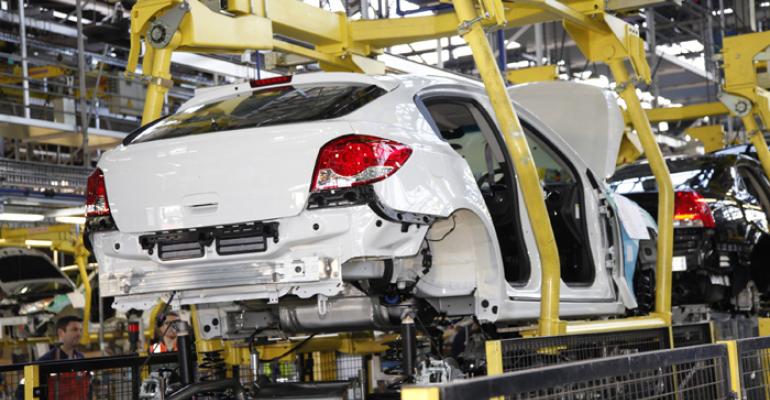Australia’s Federal Chamber of Automotive Industries dismisses critics who say the country’s vehicle-manufacturing sector is a relic of the past with no place in a national economy that must be flexible and innovative if it is to remain relevant and competitive.
FCAI CEO Ian Chalmers tells a “Cars of Tomorrow” conference in Melbourne that, to the contrary, the local industry is innovative, dynamic and creative.
“It continues to excite us with new designs, new models and new features,” he says. “It does this while making cars safer, more environmentally responsible, and – most importantly – more affordable.”
Chalmers says Australians over recent months have been misled into thinking the industry is not part of the future.
“Economic purists may call our industry archaic, past our use-by-date,” he says. “The term ‘rust bucket’ seems to flow easily from the tips of their often poisonous pens. But this characterization could not be further from the truth.”
Australia’s automotive industry, including its parts suppliers and three domestic auto makers – GM Holden, Ford and Toyota – is helping transform the nation into the fast-moving, nimble, creative and high-tech economy that Chalmers says is essential if the nation’s prosperity is to be secured into the future.
“The auto industry does this by developing and sustaining local expertise, honing technology and driving innovation,” he says. It is one of the largest employers of industrial designers and the largest customer of the tooling industry.
The sector maintains a critical demand for these skills that are needed by other parts of the Australian economy, such as mining and aerospace, he adds. It also is the largest research and development contributor in the country’s manufacturing sector, spending A$5.8 billion ($6.1 billion) over the past 10 years.
“Our industry’s ability to work remotely on global vehicle programs is a critical factor in our growing international vehicle-design and engineering influence,” Chalmers says.
“We’re increasingly in the business of exporting not just cars, but knowledge, expertise, ideas, designs and engineering solutions. The investments being made by the car companies to satisfy evolving customer expectations are helping to create jobs and enhance the automotive industry’s strategic capability.
“There can be no doubt that the industry will be part – an important part – of Australia’s technological and manufacturing future,” Chalmers adds, but he admits there are challenges.
Australia is one of the most open car markets in the world, he points out. The country’s vehicle tariffs are on average about 3.5%, down from more than 30% in 1990s.
“Most of the car-manufacturing nations, against which we compete for investment, impose tariffs and other barriers to make entry to their markets difficult for Australian car makers,” Chalmers says, sighting examples.
These include:
- European Union and U.K., 10%.
- China 25%.
- India 60%.
- Malaysia 30%; plus 105% on large cars and 75% on small cars.
- South Korea 8%.
- Russia 30%, plus 18% value-added tax on imports.
- U.S. 2.5% on cars and 25% on light-commercial vehicles.
- Thailand 80%.
- Brazil 35%, but its Industrial Products Tax that falls mainly on imported vehicles adds another 55%.
Chalmers says, in theory, free-trade agreements with an increasing number of these countries should give Australia equal access to their markets. “But it’s just not the case. Too many of our trading partners have a raft of other non-tariff barriers that make exporting to these markets virtually impossible.”
Nevertheless, Australia’s long-term policy to open its car market, increase competition and force local auto makers to be even more competitive has achieved its objectives.
“The Australian economy is undoubtedly the beneficiary of this policy-driven reform,” he says. “Today, Australia’s automotive industry is innovative, flexible and keenly competitive. Our industry boasts 60 different car brands in a 1 million-unit (annual) sales market.”
The industry directly employs more than 50,000 Australians and many more in supporting industries. It also injects billions of dollars in tax revenue and wages into the economy each year. “In short, Australia’s automotive industry provides far more than it asks,” Chalmers says.
He also says the Organization of Economic Cooperation and Development, an international group that helps governments meet the challenges of a globalized economy, has corrected its recent erroneous claim that Australia’s automotive sector is the second-most subsidized auto industry in the world.
“The OECD counted 13 years of assistance to the Australian industry as two years’ worth in its comparison,” Chalmers says. “Once calculated correctly, Australia turns out to be the lowest of the major car-making nations in terms of the level of assistance provided to the industry.”
If Australia intends to be a vibrant, innovative economy of the future, it needs the automotive industry, he says. “Sophisticated, integrated manufacturing infrastructure remains an essential element in the matrix of capabilities that will shape our national destiny.”





